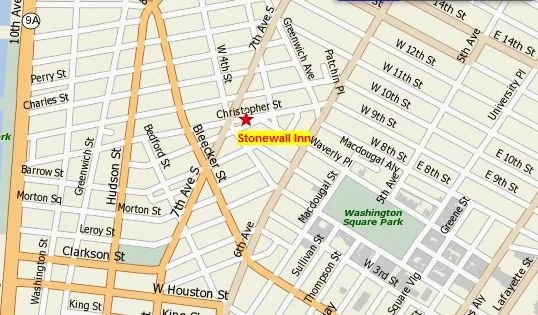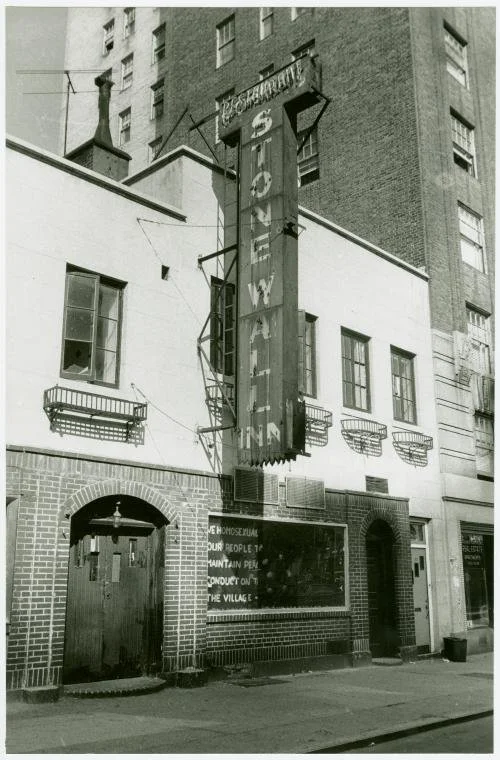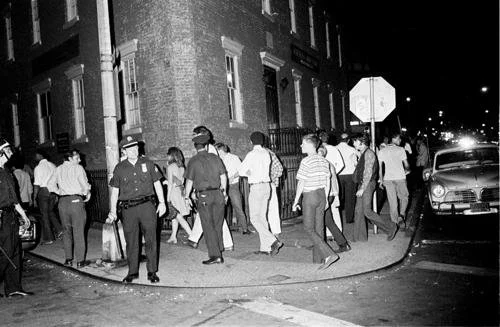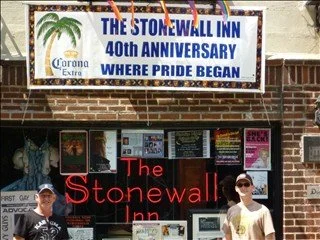STONEWALL
WHERE GAY PRIDE BEGAN
Address: Stonewall Inn,
53 Christopher Street (at 7th Avenue South),
Manhattan, New York, NY 10014 USA
Phone: 1-212-488-2705
Website: www.thestonewallinnnyc.com
Train: Take the 1 train to Christopher Street train stop or take the
A,B,C,D,E,F or V to West 4th.
Exit station onto 6th Avenue and walk one block up Waverly Place to Christopher Street.
The building was originally constructed between 1843 and 1846 as two separate stables.
The property was turned into a restaurant in 1930 and remained a restaurant until it was gutted by fire in the mid 1960s.
On 18 March 1967, the Stonewall Inn opened and at this time it was the largest gay establishment in the United States although, as with most gay clubs at the time, police raids were common.
A few months after the Stonewall Riots that started 28 June 1969, The Stonewall Inn closed.
Over the next twenty years, the building was occupied by various other businesses, including a bagel sandwich shop, a Chinese restaurant, and a shoe store.
In the early 1990s, a new gay bar, called "Stonewall" opened in the west half of the original Stonewall Inn building.
Each year during the Gay Pride March, crowds gather outside the Stonewall to remember, celebrate and enjoy its rich history.
In June 1999, through the efforts of the Greenwich
Village Society for Historic Preservation and the Organization of Lesbian and Gay Architects and Designers, the area including Stonewall was listed on the National Register of Historic Places for its historic significance to gay and lesbian history.
The area included the Stonewall Inn, Christopher Park, and portions of surrounding streets and sidewalks.
The area was declared a National Historic Landmark in February 2000.
STONEWALL RIOTS
The Stonewall riots are regarded by many gay, lesbian, bisexual and transgender persons as the single most important event. They were the beginning of the modern GLBT rights movement.
The 1960's were a heightened time for human and civil rights issues and the gay, lesbian, bisexual and transgender (GLBT) people grew increasingly intolerant of continued harassment and arrests by police.
LGBT people were subjected to civil laws that criminalized sodomy and, in New York City, allowed bars to refuse service to LGBT patrons.
Arrests, harassment and instances of entrapment by police were frequent.
Civil laws reinforced their actions. Establishments often cited Section 106, Subsection 6 of the New York State Penal Code to refuse service to queer patrons.
The code barred premises from becoming "disorderly houses."
Many, including the courts, considered homosexual patrons to be disorderly.
In establishments where LGBT patrons were served, they could not touch each other while they danced.
Section 722, Subsection 8 of the New York State Penal Code made it an offense to "solicit men for the purpose of committing a crime against nature."
Again, it was argued that homosexuality was an act against nature.
Queer patrons were often entrapped by plain clothes police officers, posing as regular bar patrons.
Transgender people were openly arrested on the streets.
One establishment where LGBT patrons found refuge was the Stonewall Inn.
Stonewall Inn October 1969 - © New York Public Library
On the Window: "We homosexuals plead with our people to please help maintain peaceful and quiet conduct on the streets of the Village"
To gain entey, bar goers paid a US$3.00 entrance charge and signed a register book (often with a fictitious or humorous name).
Bar management was often tipped off when the local police district planned a raid on the bar and would warn LGBT patrons by turning on the lights.
Stonewall Inn Layout 1969
The iconic movie star/singer Judy Garland had died on Sunday 22 June 1969 and her funeral had taken place on Friday 27 June 1969.
Because of the funeral there was a larger number of patrons at the Stonewall Inn this particular night.
At 1:20am Saturday 28 June 1969, the NYPD First District raided the Stonewall Inn.
Instead of quietly dispersing, as police had come to expect, the crowd rioted as arrests of bar staff and patrons were made.
The butch lesbians and drag queens fought back.
The bar patrons threw bottles and rocks at the police.
This raid and the riot that followed led to more demonstrations and conflicts with the police outside the Stonewall Inn as well as Christopher Park, and along neighbouring streets until Thursday 3 July 1969.
© Larry Morris/The New York Times
The West Side Savings Bank at the intersection of Seventh Avenue
South, West Fourth Street and Christopher Street.
The bank's windows had been smashed by rioters on the afternoon
of Saturday, 28 June 1969, and the lights may have been kept on
to discourage a repeat attack.
© The New York Times Sunday 29 June 1969
There were reports of stilettos, bottles, coins, bricks and debris thrown.
© Larry Morris/The New York Times
Police officers kept a tight rein on a crowd to keep them on the
sidewalks, and off the streets, at the corner of Waverly Place and
Christopher Street, half block from the Stonewall Inn.
© The New York Times Monday 30 June 1969
The altercation spilled into the streets and more queer street youth joined in the uprising.
© Larry Morris/The New York Times
The corner of Christopher and Gay Streets on the late evening of Wednesday, July 2, 1969, the sixth and final night of the Stonewall uprising.
The police officer with the helmet and night stick was a member of the Tactical Patrol Force called in for the riots.
© The New York Times Thursday 3 July 1969
As word spread, more LGBT people from surrounded neighbourhoods (suburbs/districts) joined the riot.
© Larry Morris/The New York Times
The front of the Stonewall Inn, with a crowd in front. Some time after the first night of the uprising, the owners of the club had a string of light bulbs placed over the sign in an attempt to lure customers back—and perhaps also as a gesture of defiance to the police.
Unfortunately very few images of the Stonewall Rebellion were captured by the press or participants. The handful of pictures that have circulated are able to capture the atmosphere of the uprising.
Stonewall marked the first time that gays and lesbians as a group forcefully and vocally asserted their rights to equality under the law. The events of Stonewall opened the door for millions of gay and lesbians to begin pressing for full and equal civil rights. Indeed, within a few short years of Stonewall, thousands of gay and lesbian civil rights organizations had sprung up. This historic site, which is commemorated annually in thousands of parades and festivals around the world, is recognized as a truly significant place in the history of the modern civil rights movement.
On the first year anniversary of Stonewall, the first gay pride march was held in New York City, as well as in other cities.
This rebellion helped to lead the way to the worldwide Gay Pride Parades and Fair Days as we know them today.
If you are GLBT or GLBT friendly and coming to New York City or already live there this is one bar that you should go to.
© Lauren Klain Carton
A recent picture inside the ground floor bar.
A lot of GLBT history goes with this bar but do not expect the typical jazzy light dazzling night club but a very friendly venue full of character and charm.
Buy yourself a drink and there is every chance of bumping into someone from another country who is there for the same reason as you.
It can be an emotional experience for some if you allow your feelings to vision that eventful night back in 1969.
© Rainbow Store
The owners of Rainbow Store at the Stonewall Inn for the 40 year Stonewall anniversary on 28 June 2009.
Rainbow Store respects the identity of any individual past and present in this Stonewall History article and greatly appreciates the courage of all those people who were involved in this momentous occasion in history.
Rainbow Store appreciates the copyright owners of all text and pictures in this article.
To the best of our knowledge the information mentioned here is correct as of 1 July 2024.
Stonewall Inn October 1969 - © New York Public Library
On the Window: "We homosexuals plead with our people to please help maintain peaceful and quiet conduct on the streets of the Village"
To gain entry, bar goers paid a US$3.00 entrance charge and signed a register book (often with a fictitious or humorous name).
Bar management was often tipped off when the local police district planned a raid on the bar and would warn LGBT patrons by turning on the lights.
Stonewall Inn Layout 1969
The iconic movie star/singer Judy Garland had died on Sunday 22 June 1969 and her funeral had taken place on Friday 27 June 1969.
Because of the funeral there was a larger number of patrons at the Stonewall Inn this particular night.
At 1:20am Saturday 28 June 1969, the NYPD First District raided the Stonewall Inn.
Instead of quietly dispersing, as police had come to expect, the crowd rioted as arrests of bar staff and patrons were made.
The butch lesbians and drag queens fought back.
The bar patrons threw bottles and rocks at the police.
This raid and the riot that followed led to more demonstrations and conflicts with the police outside the Stonewall Inn as well as Christopher Park, and
along neighbouring streets until Thursday 3 July 1969.
© Larry Morris/The New York Times
The West Side Savings Bank at the intersection of Seventh Avenue South, West Fourth Street and Christopher Street.
The bank's windows had been smashed by rioters on the afternoon of Saturday, 28 June 1969, and the lights may have been kept on to discourage a repeat attack.
© The New York Times
Sunday 29 June 1969
There were reports of stilettos, bottles, coins, bricks and debris thrown.
© Larry Morris/The New York Times
Police officers kept a tight rein on a crowd to keep them on the sidewalks, and off the streets, at the corner of Waverly Place and Christopher Street, half block from the Stonewall Inn.
© The New York Times
Monday 30 June 1969
The altercation spilled into the streets and more queer street youth joined in the uprising.
© Larry Morris/The New York Times
The corner of Christopher and Gay Streets on the late evening of Wednesday, July 2, 1969, the sixth and final night of the Stonewall uprising.
The police officer with the helmet and night stick was a member of the Tactical Patrol Force called in for the riots.
© The New York Times Thursday 3 July 1969
As word spread, more LGBT people from surrounded neighborhoods (suburbs/districts) joined the riot.
© Larry Morris/The New York Times
The front of the Stonewall Inn, with a crowd in front. Some time after the first night of the uprising, the owners of the club had a string of light bulbs placed over the sign in an attempt to lure customers back—and perhaps also as a gesture of defiance to the police.
Unfortunately very few images of the Stonewall Rebellion were captured by the press or participants.
The handful of pictures that have circulated are able to capture the atmosphere of the uprising.
Stonewall marked the first time that gays and lesbians as a group forcefully and vocally asserted their rights to equality under the law. The events of Stonewall opened the door for millions of gay and lesbians to begin pressing for full and equal civil rights. Indeed, within a few short years of Stonewall, thousands of gay and lesbian civil rights organizations had sprung up. This historic site which is commemorated annually in thousands of parades and festivals around the world, is recognized as a truly significant place in the history of the modern civil rights movement.
On the first year anniversary of Stonewall, the first gay pride march was held in New York City, as well as in other cities.
This rebellion helped to lead the way to the worldwide Gay Pride Parades and Fair Days as we know them today.
If you are GLBT or GLBT friendly and coming to NYC or already live there this is one bar that you should go to.
© Lauren Klain Carton
A picture inside the ground floor bar.
A lot of GLBT history goes with this bar but do not expect the typical jazzy light dazzling night club but a very friendly venue full of character and charm.
Buy yourself a drink and there is every chance of bumping into someone from another country who is there for the same reason as you.
It can be an emotional experience for some if you allow your feelings to vision that eventful night back in 1969.
© Rainbow Store
The owners of Rainbow Store at the Stonewall Inn for the 40 year Stonewall anniversary on 28 June 2009.
Rainbow Store respects the identity of any individual past and present in this Stonewall History article and greatly appreciates the courage of all those people who were involved in this momentous occasion in history.
Rainbow Store appreciates the copyright owners of all text and pictures in this article.
To the best of our knowledge the information mentioned here is correct as of 1 July 2025.












